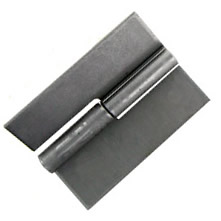
Have you heard of loose joint hinges? Like all hinges, they are used to create a limited angle of rotation between two objects. You can install them on doors, cabinets, gates and other objects. All hinges are mechanical bearings that create a limited angle of rotation. Loose joint hinges, though, aren’t the same as standard hinges. They feature a unique design that distinguishes them from their standard counterparts.
What Is a Standard Hinge?
A standard hinge is a conventional hinge that features two leafs and a single knuckle. Each of the two leafs features half of the knuckles that run from the top to the bottom on the inner side. When you place the two leafs together, they’ll form a single knuckle. A pin is inserted through the hollow center of this formed knuckle to hold the two leafs together.
What Is a Loose Joint Hinge?
Also known as a slip hinge, a loose joint hinge is an alternative type of hinge that’s characterized by the use of two knuckles — one for each leaf. One of the leafs features the pin, whereas the opposite leaf features the hole. Loose joint hinges look like standard hinges. As previously mentioned, they both both two leafs. And when these two leafs are joined, they create a limited angle of rotation. Nonetheless, loose joint hinges are different than standard hinge in a few ways.
Differences Between Standard Hinges and Loose Joint Hinges
The main difference between standard hinges and loose joint hinges is that the former features the same knuckle patterning on each leaf, whereas the latter features the pin on one leaf and a hole on the opposite leaf. With a standard hinge, the knucke patterning looks the same on both leafs. This allows the two leafs to be pressed together, resulting in the formation of a single knuckle that can be secured with a pin.
Loose joint hinges feature a different design. They still have two leafs, but the leafs don’t have the same knuckle patterning. Instead, one of the leafs featurs a hollow tube with a hole in the center, whereas the other leaf features a pin. You can connect the two leafs by placing the leaf with the hole over the leaf with the pin.
This alternative knuckle design allows for the removal of a connected object without removing the entire hinge. If a loose joint hinge is installed on a door, for example, you can lift the door off the frame. One of the leafs will come off with the door. The other leaf will remain attached to the frame.
